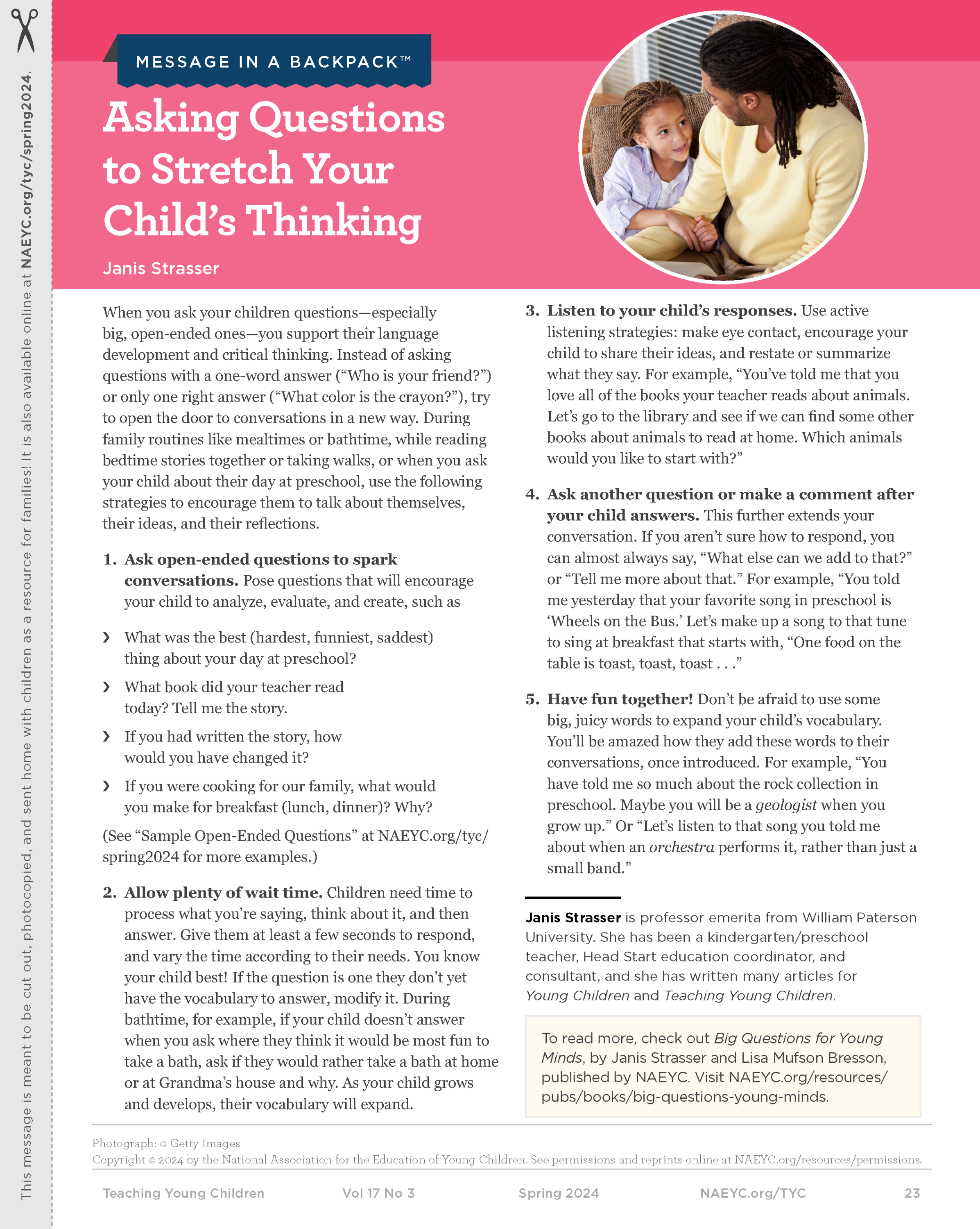Message in a Backpack™. Asking Questions to Stretch Your Child’s Thinking

You are here
When you ask your children questions—especially big, open-ended ones—you support their language development and critical thinking. Instead of asking questions with a one-word answer (“Who is your friend?”) or only one right answer (“What color is the crayon?”), try to open the door to conversations in a new way. During family routines like mealtimes or bathtime, while reading bedtime stories together or taking walks, or when you ask your child about their day at preschool, use the following strategies to encourage them to talk about themselves, their ideas, and their reflections.
1. Ask open-ended questions to spark conversations. Pose questions that will encourage your child to analyze, evaluate, and create, such as
- What was the best (hardest, funniest, saddest) thing about your day at preschool?
- What book did your teacher read today? Tell me the story.
- If you had written the story, how would you have changed it?
- If you were cooking for our family, what would you make for breakfast (lunch, dinner)? Why?
(See “Sample Open-Ended Questions” below for more examples.)
2. Allow plenty of wait time. Children need time to process what you’re saying, think about it, and then answer. Give them at least a few seconds to respond, and vary the time according to their needs. You know your child best! If the question is one they don’t yet have the vocabulary to answer, modify it. During bathtime, for example, if your child doesn’t answer when you ask where they think it would be most fun to take a bath, ask if they would rather take a bath at home or at Grandma’s house and why. As your child grows and develops, their vocabulary will expand.
3. Listen to your child’s responses. Use active listening strategies: make eye contact, encourage your child to share their ideas, and restate or summarize what they say. For example, “You’ve told me that you love all of the books your teacher reads about animals. Let’s go to the library and see if we can find some other books about animals to read at home. Which animals would you like to start with?”
4. Ask another question or make a comment after your child answers. This further extends your conversation. If you aren’t sure how to respond, you can almost always say, “What else can we add to that?” or “Tell me more about that.” For example, “You told me yesterday that your favorite song in preschool is ‘Wheels on the Bus.’ Let’s make up a song to that tune to sing at breakfast that starts with, “One food on the table is toast, toast, toast . . .”
5. Have fun together! Don’t be afraid to use some big, juicy words to expand your child’s vocabulary. You’ll be amazed how they add these words to their conversations, once introduced. For example, “You have told me so much about the rock collection in preschool. Maybe you will be a geologist when you grow up.” Or “Let’s listen to that song you told me about when an orchestra performs it, rather than just a small band.”
Download the PDF for this Message in a Backpack™ here!
Sample Open-Ended Questions
Questions to ask about your child’s day:
- Did something happen today that made you feel proud? Tell me about it.
- What book did your teacher read today? Tell me the story.
- What foods did you see at preschool today that were new or different? Tell me about them.
Questions to ask during mealtimes:
- What are some words we could use to describe the chicken (rice, vegetables) we’re eating? Let’s think of words that describe how it smells (tastes, sounds like when we chew).
- How could we make a menu to show what we’re going to have for dinner tomorrow?
Questions to ask before a bedtime story:
- What do you think the story will be about? (Look at the front and back covers.)
- Do you think this will be a story that really happened (nonfiction) or a pretend story? Why?
- What does the illustration (picture) on the front (back) cover make you think of? How does it make you feel? Why?
Questions to ask after reading a bedtime story:
- What did you think about the story? Did you like it? Why?
- What was your favorite part? Why?
- Can you think of a different ending? Tell me about it.
- What would you like to tell the author (illustrator) about the book?
To read more, check out Big Questions for Young Minds, by Janis Strasser and Lisa Mufson Bresson, published by NAEYC. Visit NAEYC.org/resources/pubs/books/big-questions-young-minds.
Photograph: © Getty Images
Copyright © 2024 by the National Association for the Education of Young Children. See permissions and reprints online at NAEYC.org/resources/permissions.
Janis Strasser is professor emerita from William Paterson University. She has been a kindergarten/preschool teacher, Head Start education coordinator, and consultant, and she has written many articles for Young Children and Teaching Young Children. For the past several years, Dr. Strasser has been working with preschool teachers on the island of Anguilla during the winter months.
